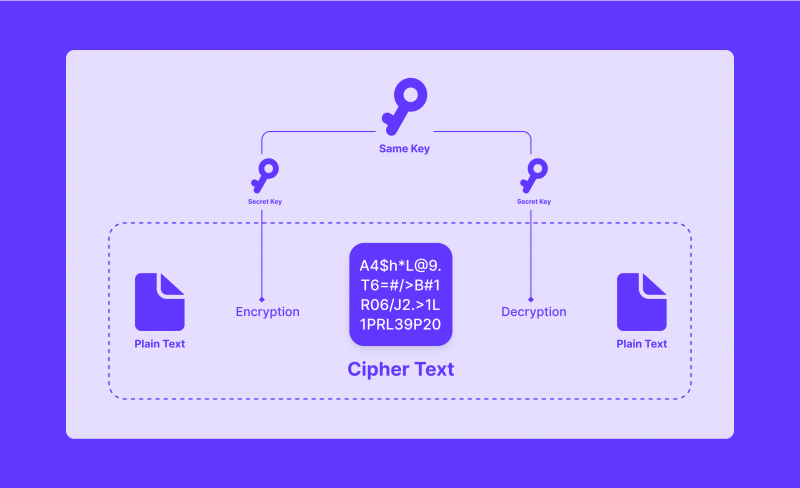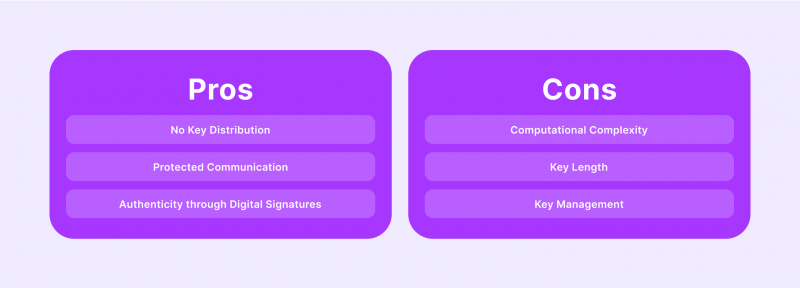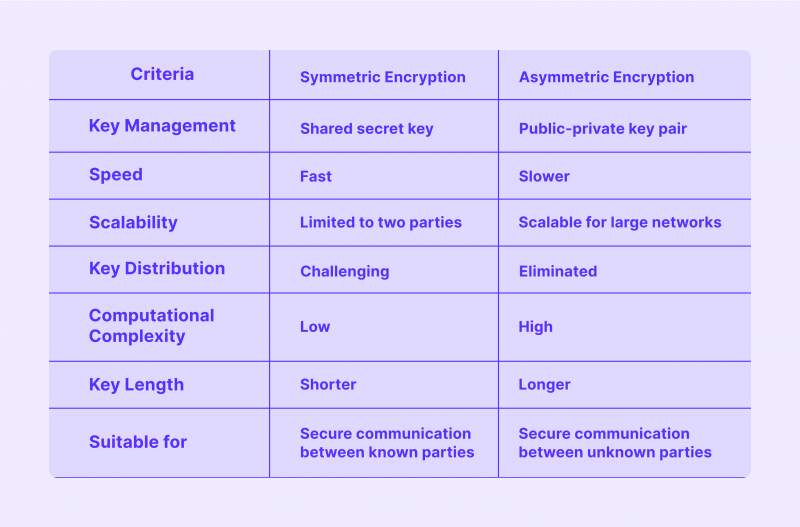Cryptographic preservation of data is a task that has never been more important than today. Whether for preserving personal information or sensitive business records, encryption is the first defence against cyber attacks, especially in the cryptocurrency and payments industries.
Two commonly used types of encryption in cryptography are symmetric and asymmetric. While both serve the same purpose, they have slightly different approaches to safeguarding the data.
So, what is the difference between symmetric and asymmetric ciphering? And which one is better?
Key Takeaways
- Symmetric encryption relies on a shared secret key, while asymmetric uses a pair of two keys.
- Asymmetric encryption addresses the challenges of key distribution and secure communication with unknown parties.
- Both methods find their use in modern applications and serve different purposes depending on the level of security and efficiency required.
Symmetric Encryption
Symmetric encryption, also known as secret-key ciphering, is the simplest method of ciphering messages. It involves using a single key for both encryption and decryption procedures. This key can be a string of bits, a mathematical algorithm, or a set of random words known only by the originator and receiver.
The same key is used by both the sending and receiving parties, hence the term “symmetric.” The key is kept confidential and must be exchanged securely.
How Symmetric Encryption Works
The process involves three main steps:
Key Generation
A secret key is generated using a random number generator or a secure algorithm. The length of the key depends on the level of security required by the sender and recipient. Generally, longer keys are considered more secure, as they provide more possible combinations for an attacker to guess.
Encryption
The plaintext message is divided into fixed-size blocks, and the secret key is applied to each block using a process called a “cipher.” The result of this operation is referred to as the ciphertext.
Decryption
As the recipient obtains the encrypted message, they use the same secret key as the sender to reverse the ciphering process, which involves applying a decipher operation on each block of ciphertext to retrieve the original message.

Advantages
Symmetric-encryption operation offers several advantages for users and developers:
- Speed: Its algorithms are computationally efficient and ideal for quickly encrypting large amounts of data.
- Simplicity: It is straightforward to implement and requires less computational power than asymmetric encryption.
- Communication Security: It ensures safe communication between individuals who possess the same secret key.
Disadvantages
At the same time, symmetric encryption also has its limitations:
- Key Distribution: The main challenge with symmetric encoding is securely distributing the secret key to all parties involved. The entire system’s security is at risk if the key is compromised.
- Scalability: This method is not scalable for large networks or scenarios where multiple parties need to communicate securely.

Asymmetric Encryption
Asymmetric encryption, also referred to as public-key encryption, is a modern cryptographic technique that uses a pair of public and private keys. The public key is available to anyone, while the private key remains confidential. Asymmetric ciphering offers a solution to the key distribution problem faced by symmetric digital security.
How Asymmetric Encryption Works
In this type of cryptographic algorithm, the same three processes are involved. However, compared to the previously mentioned method, there are slight differences:
Key Generation
The process starts with generating a key pair – a public key and a secret key. Despite their mathematical relationship, these keys cannot be deduced from one another. The public key is then shared with anyone who wants to communicate securely with the private key owner.
Encryption
To send a message securely in an asymmetric model of cryptographic security, the sender uses the recipient’s public key to cipher the message. This process transforms the original data into encrypted code, rendering it unreadable to anyone who does not own the secret key.
Decryption
Only the recipient of the encrypted data can use their corresponding secret key to decrypt the message and retrieve the original plaintext. Asymmetric encoding ensures that only authorised parties can access critical information, adding an extra layer of security to the communication process.

Advantages
Here are the main benefits this type of encryption provides:
- Key Distribution: It eliminates the need for secure key distribution. The public key can be shared with everyone, while the private key must remain a secret.
- Secured Communication: It guarantees confidentiality and trust between parties who have never met before or have no prior agreement on a shared secret key.
- Digital Signatures: It enables the creation of digital signatures, providing authenticity to digital documents.
Disadvantages
However, the method is not without its pitfalls:
- Computational Complexity: Its algorithms are computationally intensive and slower compared to the symmetric approach. Thus, it is harder to transmit large volumes of data with this method.
- Key Length: Longer key lengths are required for adequate security in asymmetric encryption compared to the symmetric algorithm.
- Key Management: This method requires careful management of key pairs to prevent unauthorised access to private keys.

When to Use Symmetric vs Asymmetric Encryption?
Both types of cryptographic operations have their strengths and weaknesses, making them suitable for different use cases.
Symmetric is faster and more efficient, perfect for handling large amounts of data. On the other hand, asymmetric encoding offers greater security as parties do not need to exchange their secret keys.

Implementation of Symmetric Encryption
Some common examples of symmetric encoding in use include secure messaging apps like WhatsApp and Signal, which use the Signal Protocol for end-to-end encryption.
In the banking sector, bulk encryption of large amounts of data is done by implementing certain symmetric-encryption algorithms. Payment applications, such as card transactions, utilise symmetrically encrypted data to protect personal identifying information (PII) and prevent identity theft or fraudulent charges.
Asymmetric Encryption in Today’s Applications
Asymmetric encoding, on the other hand, finds widespread use in modern applications. Cryptography in blockchain is of particular importance.
Most cryptocurrencies, such as BTC and ETH, employ asymmetric encryption to manage addresses on the blockchain. Moreover, this method safeguards smart contracts as well.
In the SSL and TLS protocols that are applied to secure data transmissions between a user’s browser and the server, asymmetric encoding is one of the most crucial elements of the key exchange process.
Asymmetric data protection is also a base for the security of email communication protocols such as PGP and S/MIME. These protocols use public and private keys to protect email content, ensuring only the person with the correct private key can decipher and read the message, providing privacy and protecting message integrity.
Closing Thoughts
In today’s digital era, data holds the greatest value for any organisation and project. When an increase in cybercrimes and breaches poses a significant threat to information or individuals’ assets, robust and strong cryptographic techniques become the need of the hour.
FAQ
What is AES?
AES is a well-known symmetric approach designed to protect sensitive data from unauthorised access. It operates by converting data into blocks and cryptographically securing each block separately using a combination of substitution, transposition, and mixing techniques.
What is RSA?
RSA is an asymmetric algorithm that uses the factorisation of two prime numbers to deliver robust protection. It is widely used to secure key exchanges and digital signatures, providing high security for critical data.
AES vs RSA encryption: how do they differ?
AES and RSA are two different methods with distinct strengths and applications. While AES is a symmetric algorithm designed for fast ciphering and deciphering data, RSA is an asymmetric method used primarily for secure key exchange and digital signatures. They differ in terms of speed, key length, and use cases. Both AES and RSA are considered to be highly secure ciphering algorithms when implemented correctly.
Can a quantum computer break AES?
No, a quantum computer cannot decrypt AES if sufficiently large key sizes are used. Quantum computers excel at solving certain mathematical problems that traditional computers struggle with, making them a threat to existing ciphering methods. However, if you use longer key lengths in AES (256 bits or more), the time and resources required for a quantum machine to decrypt the message become impractical.











